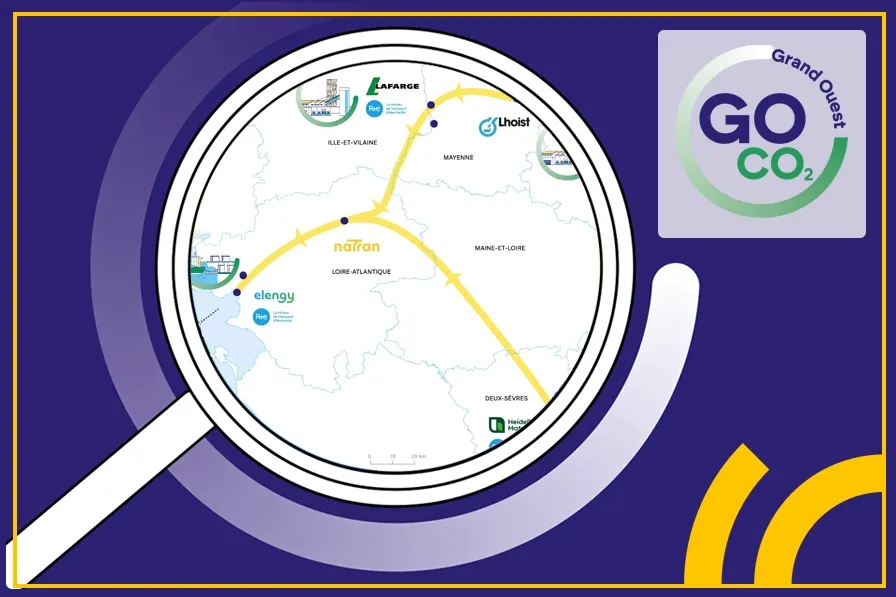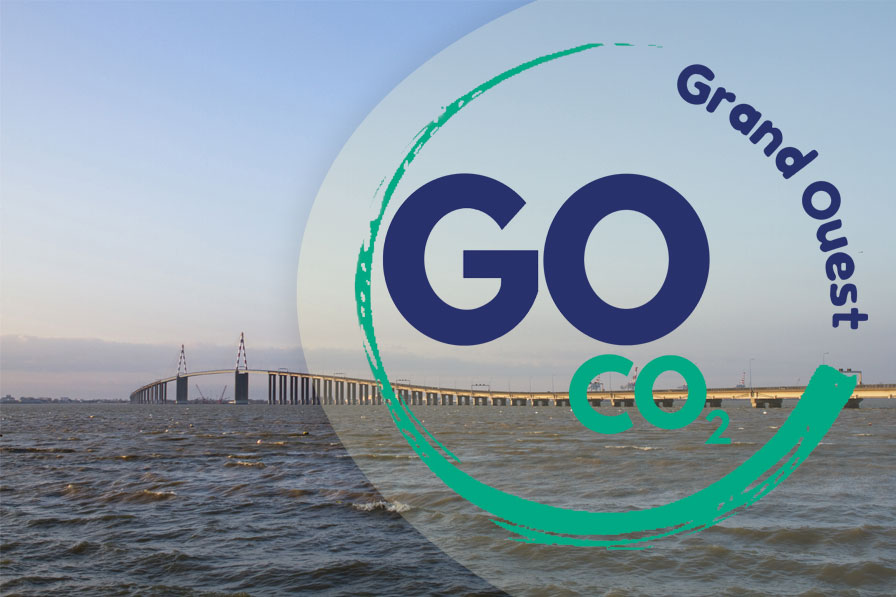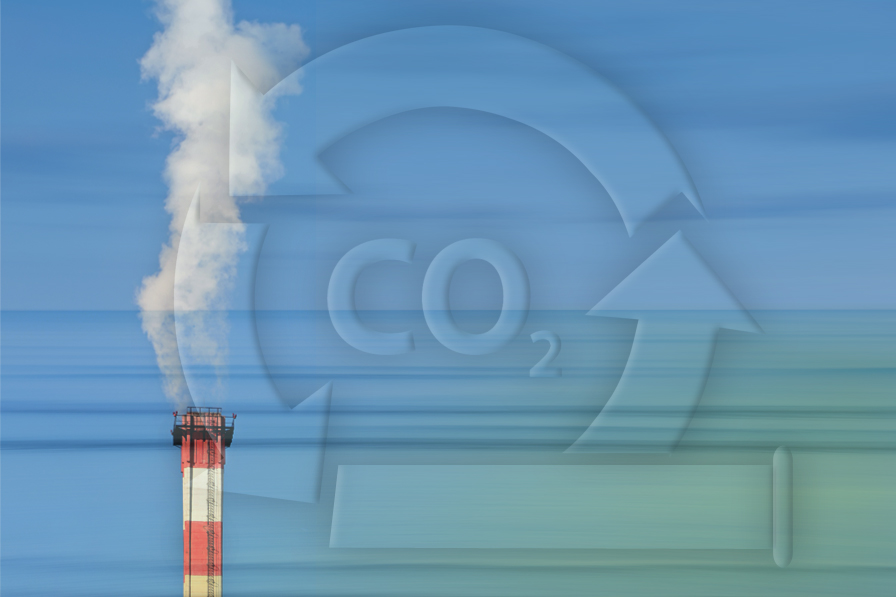GOCO₂ preliminary consultation: a key project for the decarbonisation of the Western France

The fight against climate change requires manufacturers to reduce their greenhouse gas emissions. However, some processes inevitably generate CO₂. There is a solution for dealing with residual CO₂ (known as 'fatal' CO₂), after other reduction levers have been put in place: its capture and then geological storage. This is the background tothe GOCO₂ project, for "Grand Ouest CO₂", which brings together a consortium of industrial and energy stakeholders, including NaTran. A public consultation will run until 19 December 2025.
Launched in 2021, GOCO2 is a large-scale project to decarbonise industries in the Grand Ouest region, covering several départements: Deux-Sèvres, Mayenne, Maine-et-Loire, Ille-et-Vilaine and Loire-Atlantique. It is based on a CO2 pipeline project to be operated by NaTran, some 375 km long, which will transport CO2 from several regional industrial sites to Elengy's terminal in Montoir-de-Bretagne (Loire-Atlantique). It is scheduled to come into service in 2031.
"The story of GOCO₂ began at the initiative of local manufacturers with high CO2 emissions who approached NaTran to look for solutions to limit their CO2 emissions into the atmosphere."Laurent Muzart
Laurent Muzart, H2-CO2 Development Project Manager at NaTran
The origins of the project
"The story of GOCO₂ began at the initiative of local manufacturers with high CO2 emissions who approached NaTran to look for solutions to limit their CO2 emissions into the atmosphere. Our first role was to listen to them and understand their needs and the associated industrial challenges," explains Laurent Muzart, H2-CO2 Development Project Manager at NaTran.
NaTran quickly imagined the possibility of creating a dedicated infrastructure. "We decided to use our historical gas expertise to build a complete CO₂ capture, recovery and storage chain," explains Laurent Muzart.
What is GOCO₂?
The GOCO2 project is part of the CCUS (carbon capture, utilisation and storage) approach, which aims to capture, utilise and store CO2. This is a decarbonisation solution for "fatal" CO2, i.e. the incompressible CO2 released by the industrial process itself, independently of its energy supply.
Once captured from industrial emitters, the CO2 is transported to supply specific uses by other industries (in particular the production of synthetic fuels or by-products) or, once liquefied at the Elengy terminal in Montoir-de-Bretagne (Loire-Atlantique), to permanent geological storage sites under the seabed by sea.
However, CCUS technology and its CCS variant (carbon capture and storage, which does not include recovery of the captured CO2) are not intended to replace other decarbonisation levers. "This is a complementary solution recognised by the IPCC (Intergovernmental Panel on Climate Change) for achieving carbon neutrality, and concerns the CO₂ remaining after manufacturers have implemented all possible reduction measures," stresses Laurent Muzart.
What are GOCO2's objectives?
The infrastructure is designed to transport 2.2 million tonnes of CO2 by 2031, equivalent to the emissions of the city of Nantes, helping to achieve national and European decarbonisation targets.
From a regional perspective, GOCO2 will also help to secure the future of certain industrial activities and attract new stakeholders looking for decarbonisation solutions.
What is the route of the GOCO₂ project?

The final route will be determined at the end of the current studies, taking into account consultations with stakeholders and the public.
For overland transport of CO2, several options are being studied in order to identify the most suitable route. The aim is to minimise the impact on the environment and on existing structures (housing, farmland, infrastructure), while optimising the technical feasibility of the project and guaranteeing the long-term safety and reliability of the structure.
Who does what in GOCO₂?
- Industrial emitters. These are cement and lime producers: Heidelberg Materials France, Lafarge Ciments and Lhoist. In GOCO₂, they will find a concrete solution for achieving their decarbonisation objectives and meeting their regulatory obligations by 2030-2050, in addition to the emission reduction actions already implemented or planned.
- NaTran : as the national gas transmission operator, NaTran is the "linchpin". The group brings its skills in engineering, construction, management and operation of complex infrastructures.
- Elengy : this leading European LNG terminal services provider (also a subsidiary of NaTran) offers its expertise in processing, liquefying and loading CO₂ onto ships for transport by sea to permanent geological storage sites.
Also backed by RTE, this public interest project has received the support of the Pays de la Loire Region and the Grand Port Maritime de Nantes Saint-Nazaire (GPMNSN). It is part of the Loire Estuary Decarbonation initiative, which won the ADEME's ZIBAC (Zones Industrielles Bas Carbone) call for projects.
Designated a Project of Common Interest (PIC) by the European Union in 2024, GOCO₂ benefits from European subsidies under the Connecting Europe Facilities (CEF) call for projects, making it possible to finance part of the engineering studies.
GOCO₂: an open channel set to grow
Although currently run by a consortium, the project has been designed to welcome new players in the future. "If we build an infrastructure, it must benefit all the manufacturers who want to connect to it. We place the principle of fairness at the heart of the project," explains Laurent Muzart.
"Biomethane, hydrogen, CO₂... We are working on all the levers of the energy transition. Our mission is clear: to ensure that in the future our infrastructures transport increasingly carbon-free molecules",Amaury Mazon
NaTran's Territorial Delegate for the Centre Atlantique region
NaTran's central role in GOCO₂
For NaTran, GOCO₂ fully illustrates its development strategy: supporting the decarbonisation of energy and industry in France and Europe. "Biomethane, hydrogen, CO₂... We are working on all the levers of the energy transition. Our mission is clear: to ensure that in the future our infrastructures transport increasingly carbon-free molecules", explains Amaury Mazon, NaTran's Territorial Delegate for the Centre Atlantique region.
In GOCO₂, NaTran puts its skills and know-how at the service of everyone, respecting a key principle: treating each emitter fairly and in a non-discriminatory way. Internally, teams with a wide range of skills - engineering, sales, legal, finance, territories - work together to see the project through and bring it to life.
Prior consultation: a decisive stage
Aware of the importance of providing the public with an overview of the project, and keen to gather their opinions and questions, the partners referred the matter to the Commission Nationale du Débat Public (CNDP), which decided to organise prior consultation, given the many specific features of the project.
It began on 29 September and will run until 19 December 2025. This stage, provided for in the French Environmental Code, is intended to present the project and the issues at stake in the areas concerned, to inform the technical choices made by the project owners and, above all, to build trust.
"The pipeline route is not final. The consultation process will enable us to refine the plan with input from local authorities, associations, users, residents and the general public. It's a key moment for information and dialogue," explains Laurent Muzart. The consultation will also provide an opportunity to respond to any concerns expressed by citizens and public decision-makers.
In parallel with the preliminary consultation, an initial basic engineering phase has just been launched. The project has an ambitious timetable: an investment decision in 2028, for construction in 2029-2030 and entry into service by 2031. "GOCO₂ is a perfect illustration of our ambition to combine industrial expertise, innovation and transparency to help France and Europe on the road to carbon neutrality," concludes Amaury Mazon.
This project is co-financed by the European Union:

This project was financed by the French government as part of France 2030, operated by ADEME for the feasibility study phase.


